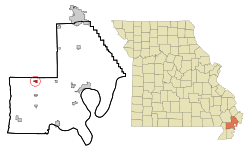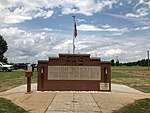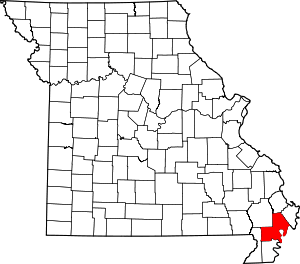Parma, Missouri
Parma is a city in New Madrid County, Missouri, United States. The population was 713 at the 2010 census.
Parma, Missouri | |
|---|---|
 Downtown Parma in 2016 | |
 Location of Parma, Missouri | |
| Coordinates: 36°36′48″N 89°49′3″W | |
| Country | United States |
| State | Missouri |
| County | New Madrid |
| Government | |
| • Mayor[1] | Rufus Williamson, Jr. |
| Area | |
| • Total | 0.64 sq mi (1.65 km2) |
| • Land | 0.64 sq mi (1.65 km2) |
| • Water | 0.00 sq mi (0.00 km2) |
| Elevation | 279 ft (85 m) |
| Population | |
| • Total | 713 |
| • Estimate (2019)[4] | 619 |
| • Density | 970.22/sq mi (374.55/km2) |
| Time zone | UTC-6 (Central (CST)) |
| • Summer (DST) | UTC-5 (CDT) |
| ZIP code | 63870 |
| Area code(s) | 573 |
| FIPS code | 29-56342[5] |
| GNIS feature ID | 0724048[6] |
History
Parma was first incorporated as a village in 1900.
At the turn of the 20th century, Parma contained two saw mills.[7]
In 1903, Parma, along with the neighboring community of Lotta, was incorporated as a village, retaining the name "Parma."[8]
It became a fourth class city in 1905.[9]
On April 14, 2015, Tyus Byrd was sworn in as the first African-American woman mayor of Parma. Byrd succeeded Randall Ramsey, who had been mayor of Parma for a total of 37 years. Shortly before Byrd was to be sworn in, four of the city's six police officers resigned, along with the city's clerk and the supervisor of water treatment.[10][11][12]
Geography
Parma is located at 36°36′48″N 89°49′03″W.[13]
According to the United States Census Bureau, the city has a total area of 0.69 square miles (1.79 km2), all land.[14]
Demographics
| Historical population | |||
|---|---|---|---|
| Census | Pop. | %± | |
| 1910 | 905 | — | |
| 1920 | 1,241 | 37.1% | |
| 1930 | 1,051 | −15.3% | |
| 1940 | 1,187 | 12.9% | |
| 1950 | 1,163 | −2.0% | |
| 1960 | 1,060 | −8.9% | |
| 1970 | 1,051 | −0.8% | |
| 1980 | 1,081 | 2.9% | |
| 1990 | 995 | −8.0% | |
| 2000 | 852 | −14.4% | |
| 2010 | 713 | −16.3% | |
| Est. 2019 | 619 | [4] | −13.2% |
| U.S. Decennial Census[15] | |||
2010 census
As of the census[3] of 2010, there were 713 people, 283 households, and 196 families residing in the city. The population density was 1,033.3 inhabitants per square mile (399.0/km2). There were 342 housing units at an average density of 495.7 per square mile (191.4/km2). The racial makeup of the city was 67.46% White, 29.45% Black or African American, 0.14% Native American, 0.56% Native Hawaiian or Pacific Islander, 1.12% from other races, and 1.26% from two or more races. Hispanic or Latino of any race were 2.81% of the population.
There were 283 households, of which 36.4% had children under the age of 18 living with them, 42.4% were married couples living together, 22.6% had a female householder with no husband present, 4.2% had a male householder with no wife present, and 30.7% were non-families. 25.4% of all households were made up of individuals, and 10.6% had someone living alone who was 65 years of age or older. The average household size was 2.52 and the average family size was 2.97.
The median age in the city was 39.8 years. 26.2% of residents were under the age of 18; 7.8% were between the ages of 18 and 24; 22.5% were from 25 to 44; 28.6% were from 45 to 64; and 15% were 65 years of age or older. The gender makeup of the city was 48.9% male and 51.1% female.
2000 census
As of the census[5] of 2000, there were 852 people, 333 households, and 229 families residing in the city. The population density was 1,325.6 people per square mile (514.0/km2). There were 383 housing units at an average density of 595.9 per square mile (231.1/km2). The racial makeup of the city was 57.39% White, 41.55% African American, 0.12% from other races, and 0.94% from two or more races. Hispanic or Latino of any race were 0.82% of the population.
There were 333 households, out of which 30.6% had children under the age of 18 living with them, 47.4% were married couples living together, 18.6% had a female householder with no husband present, and 31.2% were non-families. 28.5% of all households were made up of individuals, and 14.7% had someone living alone who was 65 years of age or older. The average household size was 2.56 and the average family size was 3.11.
In the city, the population was spread out, with 27.3% under the age of 18, 9.4% from 18 to 24, 25.8% from 25 to 44, 21.0% from 45 to 64, and 16.4% who were 65 years of age or older. The median age was 36 years. For every 100 females there were 85.6 males. For every 100 females age 18 and over, there were 78.4 males.
The median income for a household in the city was $18,804, and the median income for a family was $23,333. Males had a median income of $24,444 versus $15,804 for females. The per capita income for the city was $11,031. About 29.5% of families and 34.1% of the population were below the poverty line, including 53.8% of those under age 18 and 15.0% of those age 65 or over.
Climate
Climate is characterized by relatively long, hot summers and cool winters with evenly distributed precipitation throughout the year. The Köppen Climate Classification subtype for this climate is "Cfa" (Humid Subtropical Climate).[16]
Education
Public schools
Currently, Parma has no local school system. Students attend New Madrid County Central R-I School District in New Madrid.
History
After the founding of the community of Parma, rapid growth led to the formation of a school system. From the late 1890s to 1910, various one room structures in the Parma area were utilized for education. The first structure for strictly school purposes was erected in 1910. By 1935, an increasing student population demanded the need for a larger high school building. With 9.9 square feet per pupil, Amendment No. 3 or The School Bond was placed on the ballot. After a summer of strong campaigning from the school district and other community leaders, Amendment No. 3 passed by a vote of 284-29 on October 19, 1935. Construction commenced in the fall of 1936 and the first classes began in the fall of 1937. The original 1933 gymnasium burned in 1944. Once again, the citizens of Parma banded together to fund construction of a new gymnasium which was completed by fall of 1944. The athletic teams, known as the Parma Pirates, were the pride of the school and surrounding community. In 1980, the Parma Consolidated School District No. 5 was consolidated into the New Madrid County Central R-I School District. Over the next several decades, the school complex fell into a state of disrepair. A major fire in the fall of 2010 brought the entire high school complex to the ground.
2017 Memorial

In the summer of 2016, several PHS alumni and former community leaders formed the Parma School Memorial Committee. They were successful in their efforts to raise funds to construct a large monument on the grounds of the old high school building. The memorial was dedicated on July 1, 2017.
Public library
Parma has a lending library, a branch of the New Madrid County Library.[17]
Notable people
- Barry Aycock, agricultural land owner and businessman.
References
- Twaits, Allison (14 April 2015). "Officers, city officials resign after new mayor elected". KFVS12. Retrieved 19 April 2015.
- "2019 U.S. Gazetteer Files". United States Census Bureau. Retrieved July 26, 2020.
- "U.S. Census website". United States Census Bureau. Retrieved 2012-07-08.
- "Population and Housing Unit Estimates". United States Census Bureau. May 24, 2020. Retrieved May 27, 2020.
- "U.S. Census website". United States Census Bureau. Retrieved 2008-01-31.
- "US Board on Geographic Names". United States Geological Survey. 2007-10-25. Retrieved 2008-01-31.
- Williams, Walter (1904). The State of Missouri. pp. 459.
- "New Madrid County Place Names, 1928–1945". The State Historical Society of Missouri. Archived from the original on June 24, 2016. Retrieved November 19, 2016.
- "List of place names in New Madrid County". New Madrid County official website. Retrieved 24 April 2015.
- "Officers, city officials resign after new mayor elected". KFVS Channel 12 News. Retrieved 20 April 2015.
- "Black Mayor Is Voted In and a Small Town's Staff Empties Out". The New York Times. Retrieved 24 April 2015.
- "Resignations in tiny Parma, Mo., baffle town's first black mayor". St. Louis Post-Dispatch. Retrieved 24 April 2015.
- "US Gazetteer files: 2010, 2000, and 1990". United States Census Bureau. 2011-02-12. Retrieved 2011-04-23.
- "US Gazetteer files 2010". United States Census Bureau. Archived from the original on January 12, 2012. Retrieved 2012-07-08.
- "Census of Population and Housing". Census.gov. Retrieved June 4, 2015.
- Climate Summary for Parma, Missouri
- "Our Locations". New Madrid County Library. Retrieved 1 June 2019.
